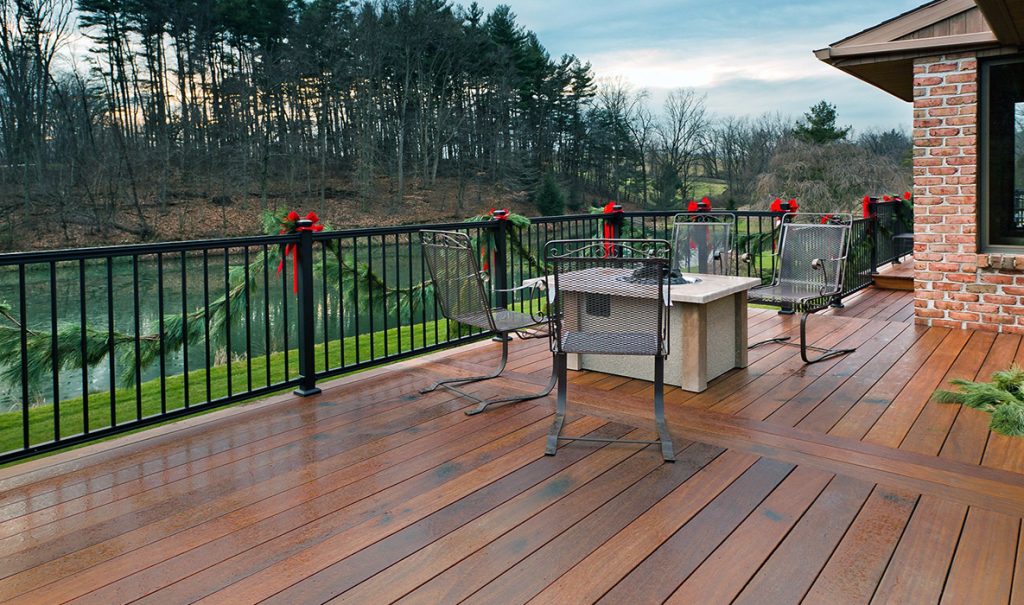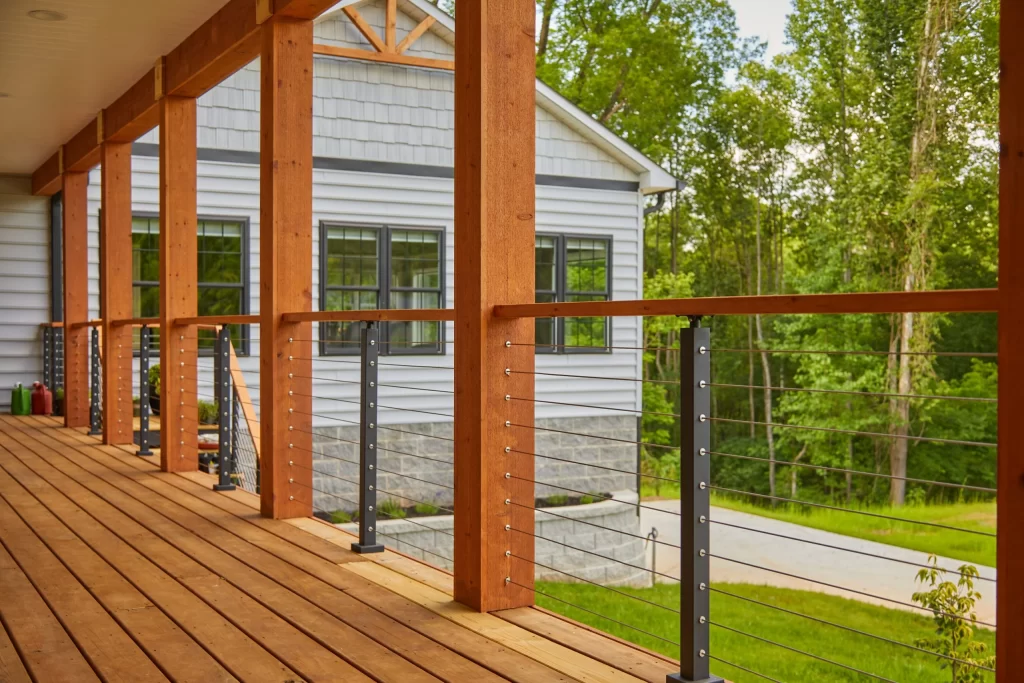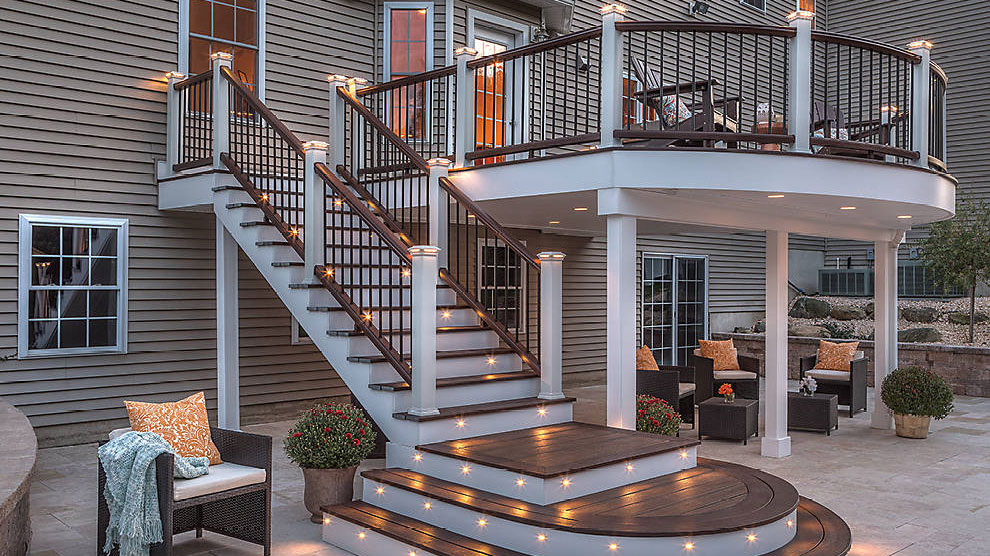What will it cost you to build a deck in Central PA when hiring a professional building or remodeling company? In this article we will break it down for you. Let us jump straight to the answer and then we will provide options and details for you.
Cost of New Deck in Danville PA
Here is the ranges of what a 480 square foot deck [30′ x 16′] would cost to build from scratch including all labor, materials, permits, inspections, and design:
- 480 ft2 Deck with Pressure Treated Pine Decking and Railing with Basic Layout and Trim:
- $20,000 – $30,000
- 480 ft2 Deck with TimberTech Composite Decking with Vinyl Railing and Basic PVC Trim:
- $35,000 – $50,000
- 480 ft2 Deck with Ipe Hardwood Decking with Custom Wire + Hardwood Railing + Trim:
- $40,000 – $60,000
- 480 ft2 Deck with TimberTech PVC Decking, Intricate PVC Trim, Lighting, + Wire Railing:
- $45,000 – $60,000
- 480 ft2 Deck with Timber Frame Pergola, Stone Pizza Oven, Mahogany Decking + Railing:
- $90,000 – $125,000
What Kind of Deck fits my Needs?
Now that we know what a 480 ft2 deck costs to build in all sorts of different configuration, let us talk about design options that you might consider as you plan out a deck build.
Composite vs. Wood Decking
The most common question we receive about deck building is, “Should I go with composite or wood decking?” There are a few factors that will determine which decking is a better fit, but in general composite is currently the most popular choice for a high-end finish with a mid-range price tag.
Composite decking comes in many color and grain patterns, and varies greatly in price, quality, and durability. A solid plank 1″ thick capped composite decking will hold up likely for 15-25 years, and will feel sturdy the entire time. If you desire a beautiful deck with little to no maintenance, composite decking is the choice for you.
Wood decking can vary from pressure treated pine to cedar to mahogany or white oak hardwoods. In general, we DO NOT recommend pressure-treated decking + railing to our clients, as this is by far the lowest quality, highest maintenance finish one could use. If you desire authentic wood decking with a beautiful aesthetic and luxurious feel, there are options to consider that are more costly but with proper maintenance will hold up for decades.
Cedar: Eastern Red Cedar is a beautiful aromatic softwood that grows natively in Pennsylvania, and has much higher rot resistance and water repellent properties than southern pine. Cedar will need to be sealed or painted every 1-2 years, but could easily last 25-50 years if maintained consistently. Cedar will be comparable in price to entry level composite decking in most cases.
Ipe: Brazilian Walnut, also known as Ipe, takes home the trophy as the golden standard for hardwood decking. This exotic hardwood is dark, beautiful, and durable. This luxurious wood will last easily for decades, but comes with a hefty initial price tag. This decking is perfect for the homeowner looking for luxury and a natural feel to their outdoor living spaces.

White Oak:
White Oak is not commonly used for decking, but it is abundantly available and very durable as a hardwood native to Pennsylvania. This wood is light in color and has a tight grain pattern, and is one of the most rot resistant woods in the state. This decking would fall somewhere between Cedar + Ipe in terms of price, and would be comparable to a Luxury PVC Decking product with custom Iron or Wire Railing.
Railing Options
The Deck railing tends to be one of the most expensive components of the deck, but is crucial to the safety and aesthetic symmetry of the entire deck. There are many options for railing, we will start from lowest cost to highest.
Vinyl Railing: Vinyl railing comes primarily in white or black, and is the basic railing used on most decks. Vinyl railing is beautiful and will last 10-20 years, but it feels less substantial than composite or hardwood railing. Most vinyl railing feels slightly flimsy and does not hold up as well as composite, but it still is a good base level option for smaller decks or homeowners trying to build curb appeal on a budget.
Composite Railing: Composite railing is a step up from vinyl, and has many designs and pattern options. Some composite railing has aluminum balusters and allows for a drink rail to be installed on top of the rail, which matches the composite decking on the deck. Composite Railing is a great choice for quality without breaking the bank, as it will hold up long term and looks and feels substantial.
Aluminum Railing: Aluminum railing can vary in color, shapes, and sizes, but a fully aluminum rail has a very sturdy look and feel to it. Aluminum railing is slightly more expensive than composite railing, but can be comparable in some instances. Aluminum does not rust, so aluminum railing will also hold up for decades. The aluminum railing will get cold and hot with the temperature variations, but it is a luxurious product with much curb appeal.
Wire Railing: Wire railing can be configured with Hardwood Posts, Aluminum posts, or standard Composite Post Sleeves. Wire railing is a modern aesthetic style that has horizontal wire instead of vertical balusters as the railing. This railing tends to be high end railing and is more complex for installation. Installed properly, this railing will provide a beautiful contrast and sleek appearance to any deck.

Hardwood Railing: Most hardwood railing systems will use either aluminum or iron balusters or a cable or wire railing system. A hardwood railing will only make sense if you are using hardwood decking, but will be the perfect product to tie together this luxury deck.
Deck Layout + Function
A basic deck layout in the shape of a square or rectangle will be much more cost effective than an intricate deck with herringbone decking, a round perimeter, or multiple levels. In general, a single level deck with square edges and a simple decking pattern will serve most peoples needs and wants. A more detailed rounded deck will cost substantially more, but will match the level of luxury and beauty afforded by many hardwood or PVC style decking systems.
A deck with a pergola or porch roof will add cost, but also will change the function of the deck. Before you build, ask yourself, “What am I going to use my deck for?”
If you plan on spending a lot of time using and entertaining on this deck, it makes sense to build a larger deck than if you are just using it for evening sunsets or grilling.
Trim, Accents, and Lighting
Different levels of fascia, riser boards, picture frame trim boards, stair lighting, and railing lighting can drastically affect the cost of a deck. Most trim will either be PVC or Composite, which can range from very basic to detailed and intricate. In essence, the more bells and whistles a deck has, the more expensive it will be.

Stairs and Gutter Systems
More intricate or detailed stairs will add drastically to the cost of the project. Grand staircases or great landings add much aesthetic value to the outdoor living space, but are very expensive to build and implement. For second story decks, a full deck gutter system that catches rainwater and collects it into gutters to keep under the deck dry are very functional, but can add $5,000 to $15,000 to the cost of the deck.
Call Today to Design Your Dream Deck
We would love to make your dream deck a reality. Schedule a Phone Consultation with our team to plan and build a deck that you and your family and friends can use, enjoy, and love to spend time on.
